![]()
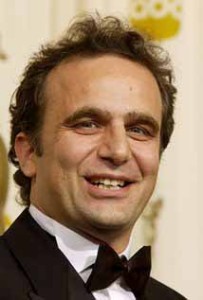
“The great thing about our relationship, which I value, is Ridley leaves me complete creative freedom and control,” shared Scalia. “That means freedom to choose takes, music, effects, performances, to build the scene any way I want. There is no specific direction at the time, so it’s my approach putting the scenes together.”
One thing that Scalia especially likes about their process is that every evening after production has wrapped, they watch dailies together along with the cinematographer and production designer. They prepare a snack and share a glass of wine and “watch movies.” It gives the team the ability to respond and share first impressions.
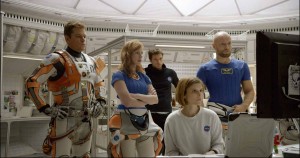
The Martian tells the story of biologist Mark Watney (Matt Damon), abandoned on the hostile planet when his crew presumes he is dead after a storm, who must find a way to stay alive until he can be rescued.
Although the story intercuts between Mars, earth and the crew ship traveling between the two planets, much of the story is focused on the lone astronaut as he narrates his plans for survival to the station’s computer. The script originally followed the basic structure of the novel in terms of having one man left alone on Mars after it is announced he has perished in an accident. Nothing is shown of Earth until Watney figures out a way to live for longer than 30 days. It was 40 minutes into the film before the story cut back to earth and they discover that he’s alive. The Hermes crew came in even later.
“When we first built the film and started in that order, it really brought the film to an end,” revealed Scalia. “It also didn’t resonate as well in terms of who these other characters are. We realized we couldn’t do that, so we changed the structure.”
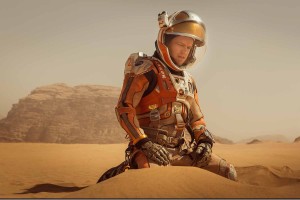 The team tried different ways of breaking up the single character scenes. They tried using a flashback to tell the backstory of the crew escaping Mars during the deadly storm, but going back to an event that the viewer already knows about lost momentum in the storytelling. “We always loved the idea of him being by himself, so we restructured. The obvious choice was to start at the beginning with the storm, but still retain the element of spending time with Watney,” explained Scalia.
The team tried different ways of breaking up the single character scenes. They tried using a flashback to tell the backstory of the crew escaping Mars during the deadly storm, but going back to an event that the viewer already knows about lost momentum in the storytelling. “We always loved the idea of him being by himself, so we restructured. The obvious choice was to start at the beginning with the storm, but still retain the element of spending time with Watney,” explained Scalia.
In the script one scene would talk about a problem and what Watney was going to do and then the next scene would jump to the solution. It was like an emotional jump cut. Scalia continued, “It was too easy. We need to spend time with him. For the character, we needed to figure the condition he was in.” Scalia recycled material from other sequences “to create more time in space of solitude, of figuring out, to experience his emotions.”
Scott liked the narrative aspect of the video diary spoken directly to camera that had the effect of directly addressing the viewer. Rather than using traditional voice over, they combined the explanations, the thought process by having the character talk to camera. If a scene or story point was not fully comprehended, clarification could be added.
“When we carried his first voice throughout the film, Ridley had the idea to put more GoPro cameras everywhere. This element of actually addressing the audience, speaking to them, looking into the camera, continues the identification process with the character,” said Scalia.
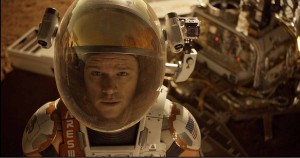 The devise allowed Scalia to jump around in time and action to illustrative scenes, with the continuation of the on camera narrative acting as a connective voice over. The key was following the character’s thought process of cause and effect to find solutions in his head, while at the same time, making the film visually interesting and keeping the viewer engaged.
The devise allowed Scalia to jump around in time and action to illustrative scenes, with the continuation of the on camera narrative acting as a connective voice over. The key was following the character’s thought process of cause and effect to find solutions in his head, while at the same time, making the film visually interesting and keeping the viewer engaged.
“It works in different layers,” revealed Scalia. “For example, when he describes the problem, which is how to make water, he starts in one place ¬ in bed, late at night watching Happy Days – then it cuts ahead in the action to what he is starting to do, but then it reverts to him being in front of the TV chiseling on the crucifix. It is a completely different time and day, but with the same dialog description.”
Another element that Scalia thought was key was the use of GoPros as a body cam on his suit and in the Rover. If the character moves, the camera is recording what is essentially his point of view.
“If he walks through the airlock, the camera is there. You are walking through him. You see his action. If he digs up the parachute and finds the Pathfinder, it’s very close,” shared Scalia. “Those were all additions that were not scripted. These are elements that come out from the way Ridley shoots, the ideas that he has. Storytelling and narrative works on many different levels. You want to show things that are intimate and vast at the same time. You have the contrast of intimate thoughts with vast landscapes.”
The film retained several things from the book: humor, sarcasm and the science of survival. In a story that focuses on a single character, a strong performance is critical. Scalia felt that Damon was perfect at capturing the spirit of the book throughout the film, including the character’s self-deprecating humor and sarcasm. The actor was also able to tap into emotional moments, such as when he tears up the first time he hears the Hermes crew and realizes he might be rescued.
The filmmakers noticed that performance during dailies. A few days later, when discussing the scene, Damon told the editor that the reaction was completely spontaneous. He did not even know where it came from, but it was in response to the first time he heard the crew’s voices after being alone on the planet.
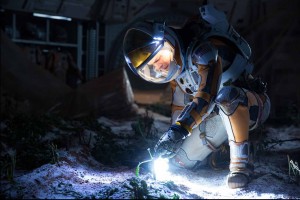 “He was reacting as the character that had been there for a very long time hearing the first human voice,” added Scalia. “The actors were all shot separately – they weren’t in the same room – so he had a really emotional reaction to it.”
“He was reacting as the character that had been there for a very long time hearing the first human voice,” added Scalia. “The actors were all shot separately – they weren’t in the same room – so he had a really emotional reaction to it.”
The fact that the actors were shot in three different locations while often reacting to temp voice over, added to the complexity of the production. Using multiple cameras, the production first shot the NASA footage, then the scenes on the Hermes, which were on a different set, and then the Watney footage.
Scalia had to cut scenes over and over as the pieces came in. Part of the editing decisions included when to cut between Mars, earth and the Hermes. Much of that was not in the script. And then there were multiple performance options. For Scalia it was balancing the choices.
A challenge in rhythmically pacing a visual effects heavy film like The Martian is not having final footage to work with until late in the editing process. VFX means editing with pre-viz and numerous iterations that fine-tune takes to frame accuracy. All the pieces do not come together until the end, so the cut changes until the very last minute. Getting the film together became even trickier when the schedule was cut from 32 to about 24 weeks because the studio advanced the release date.
According to Scalia, “It’s hard because you have to start off with large brush strokes, while at the same time you have to envision the scene, even in its rawest form. You need to have some kind of structure to a scene to be presented in terms of approval of shots before visual effects can start working.”
Scalia admitted that a lot of editing techniques were used throughout the film to keep the story progressing and interesting. Visually the film still needs a cohesive sense of rhythm. The character needs an emotional trajectory, an emotional arc that the audience can experience with him. “You have to be aware of that. It is always in the service of story and character,” stated Scalia.





